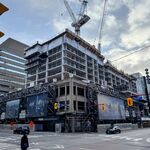drum118
Superstar
Simple.........what decade do you expect to be riding that one/two stop line as well what is the cost to do it vs the BRT??I just look at the map and wonder why we couldn’t extend the subway one stop to Dixie and a second to cooksville and call it a day.View attachment 574951
How often would a subway train depart Kipling based on 100% increase of current ridership??
What happen to the 2 stops between Kipling and Dixie??
How do you plan to run the line to Dixie since the rail corridor is dead as well Dixie to Cooksville??
Where do you plan on having a bus terminal at Dixie that service Dundas and Dixie without forcing rider to do a 10 minute walking transfer as well not forcing buses to go off route to the terminal??
Where do you see a terminal for Cooksville to meet everyone needs?
You realized that buses service will still have to run on Dundas to service stops not being service by the subway or the BRT??
A true BRT ROW is only needed to Mavis and express to Nineth Line with a few extra stations to replace a few that have been removed.
At the end of the day, the BRT will work until the blight east of Dixie is redevelop to support Rapid Transit as well upgrading west of Dixie to Mavis. Then you move to LRT as there will be no need for a subway until 2100. You want a subway before then, then be prepared for 15-30 minute service. To see what Dundas numbers are as well the 109, go to Mississauga transit thread to see the current ridership numbers.




